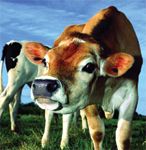USDA downgrades BSE risk
Riverdale, MD. - Government analysis shows that the nation's risk for a mad cow outbreak is so low, the United States Department of Agriculture (USDA) plans to ease testing protocols for the brain-wasting malady.
RIVERDALE, MD. — Government analysis shows that the nation's risk for a mad cow outbreak is so low, the United States Department of Agriculture (USDA) plans to ease testing protocols for the brain-wasting malady.
At the same time, the department ended its probe into the nation's latest case of bovine spongiform encephalopathy (BSE), or mad cow disease, without finding the cow's birth herd. Discovered March 13 in Alabama, the downer was a red-coated crossbreed beef cow that was hard to track because it was more than 10 years old and carried no marks, USDA says.

No hype/no panic: In April, Agriculture Secretary Mike Johanns called the nation's mad cow risk "extraordinarily low."
The agency's decision to abandon the hunt bolsters insider claims that mad cow nears eradication in the United States. Roughly 730,000 cattle tests have exposed just two diseased cows, totaling three U.S. cases. The massive testing of cow brains following the nation's first confirmed case in 2003, coupled with low incidence show severe surveillance is no longer needed, disease experts say.
"It's safe to say BSE is on its way out as a disease," says Gary Weber, PhD, executive director of Regulatory Affairs, National Cattlemen's Beef Association (NCBA). "With this low of prevalence, because of the feed ban in 1997, this disease is rapidly being eradicated in the United States."
Statistically speaking
USDA doesn't make that assertion, but the agency appears confident in the nation's food safety regarding BSE. In May, Agriculture Secretary Mike Johanns announced USDA estimates between four to seven BSE cases exist in the United States, concluding that prevalence of the disease is less than one case per million adult cattle. That figure is based on an adult cattle population of 42 million, representing aged animals. Total U.S. cattle estimates are as high as 100 million, officials say.
USDA's data, open to the public for scientific review, bolster the agency's bid to lighten its load on disease testing, which Johanns describes as an "enormous undertaking but well worth the effort." More than 1,000 cattle are tested daily, agency officials say.
"We have an extraordinarily healthy herd of cattle in our country," Johanns contended during a telenews conference on April 28. "I do expect we will move to a level of testing that is in line with international guidelines for a country like ours that is at minimal risk for the disease."
USDA plans to use the prevalence analysis once it's audited and international standards are set by the World Animal Health Organization (OIE) to design an ongoing BSE surveillance program for the United States. The data and analysis also will assist in making science-based policy and regulatory decisions related to the disease.
The OIE bases its surveillance protocols on a point scoring system, Weber says, noting that the United States should have no trouble exceeding international guidelines.
While NCBA endorses no protocols for USDA's new surveillance regimen, "I think it's safe to say you don't need to test 400,000 animals a year," Weber adds.
AABP supports scaling back
USDA reports its conclusions regarding the nation's BSE prevalence are "sound and scientifically credible." After reviewing the report, Dr. Gatz Riddell, executive director of the American Association of Bovine Practitioners, agrees.
"USDA was testing 47 times more stringently than the OIE recommended, and they say there's no need to test every animal before slaughter," Riddell says. "It seems like with all the samples USDA has taken, to only find two cases shows that our animal feed controls and human safety controls have been effectively implemented. We have real strong firewalls against this disease."
To view USDA's BSE prevalence report, visit http://www.aphis.usda.gov/.